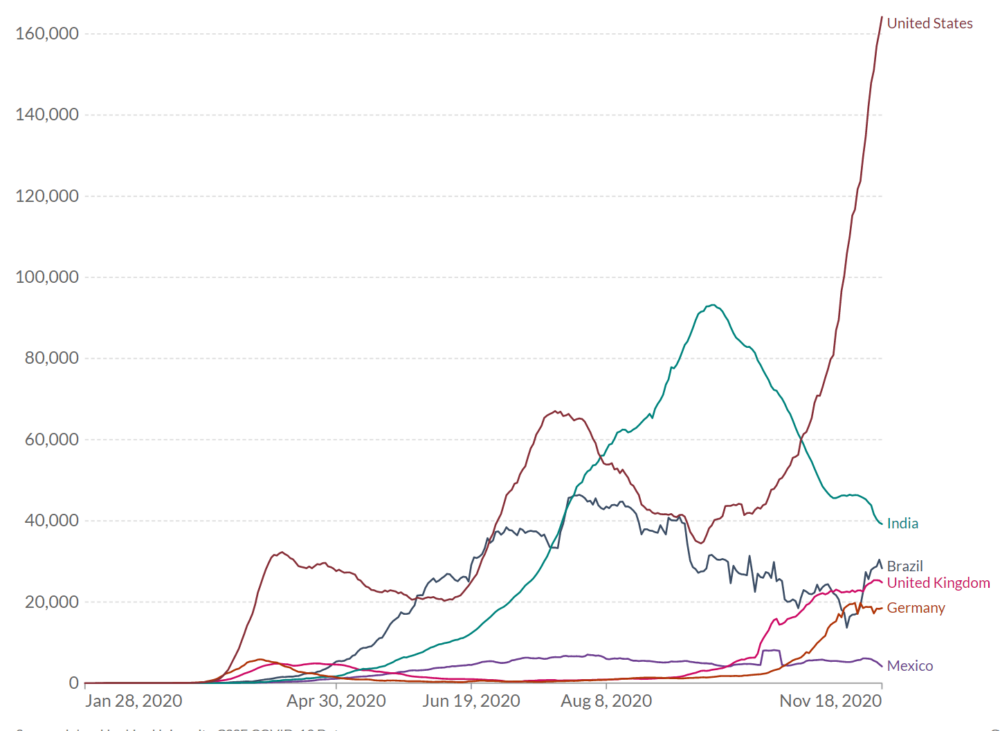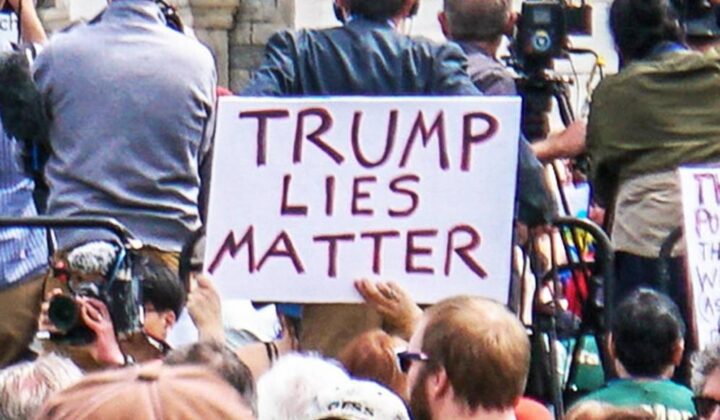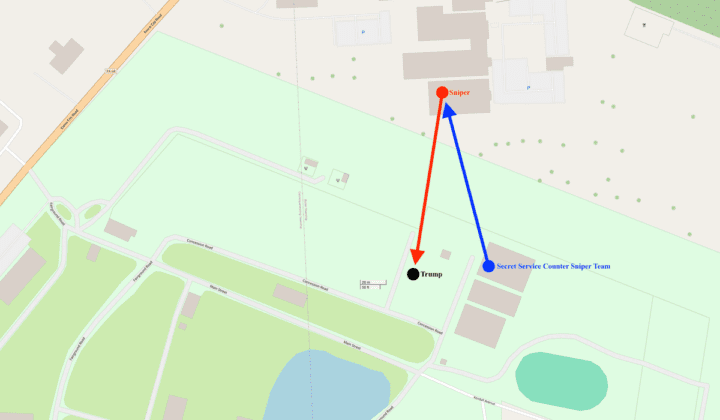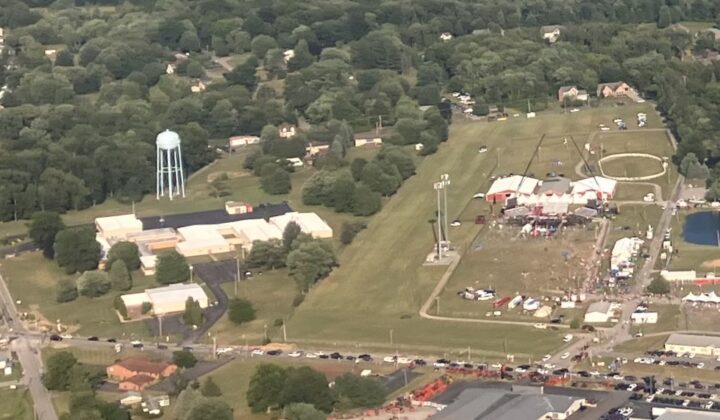America Battles a Third COVID Surge, But There is Hope
With seemingly every new day comes a grim new coronavirus record: new daily cases are at an all-time high of about 157,000 (rolling 7-day avg. as of Wed., Nov. 18, though also partly due to increased testing), hospitalizations have reached a new peak, and the past week’s death toll exceeded triple the number of people killed on 9/11.
Unlike the initial outbreak in the spring, which was concentrated in specific areas like New York City, this surge has spread all across the country: the tracking organization Covid Exit Strategy rates 47 out of the 50 states as having “uncontrolled spread.”
Prepare for a dark winter. The 1918 flu pandemic and other coronaviruses peaked during the winter. College students returning home and holiday gatherings also spell trouble. Starting from such a high number of cases means further growth will have dire consequences.
A group of highly-accurate prognosticators known as the “superforecasters” predict more than 82 million additional American cases by March 31, 2021 (56% chance), but also believe there’s a 97% chance total deaths by that date won’t exceed 630,000 due to improved treatments (both as of Wed., Nov. 18). There have been about 11 million confirmed cases and 250,000 deaths so far.
1. When will we get back to normal?
There is some debate as to when enough of the population will be immunized (about 70% is likely necessary) to allow a return to physical offices and pre-pandemic life. In the wake of Pfizer and Moderna’s stellar tentative Phase III trial results (which come with caveats), Dr. Anthony Fauci and Oxford medicine professor John Bell foresee a return to normalcy as early as next spring. As of November 15, the superforecasters’ median forecast on when the U.S. will have 200 million vaccine doses is summer 2021. The co-creator of the Pfizer vaccine candidate, professor Ugur Sahin, is cautiously optimistic that we will return to a normal winter by next year.
Polling that suggests that only 50% of the American public would take the vaccine is a cause for concern. NIH Director Dr. Francis Collins explains that it would be a pity if “we have in our hands the solution to the worst pandemic of more than 100 years, but we haven’t been able to actually convince people to take charge of it.” Nevertheless, as time passes and a vaccine’s safety is proven, we hope public attitudes will change.
2. How might decision-makers be thinking about what to close and what to keep open?
Boston University epidemiologist Helen Jenkins compares the reopening process to deciding on a budget: to keep community transmission below certain levels, public officials can only open a limited number of places. Reopenings vary in how much of the “budget” they use—for example, reopening a park is less risky than allowing indoor dining. But everywhere, the need to determine priorities remains.
Ireland, Germany, France, and England, where cases are also spiking, have closed indoor bars, restaurants, and gyms to preserve their “budget” for keeping in-person schools open. Indeed, research conducted by the consulting group McKinsey shows that remote learning will set the average student back seven months (and minority students even more), and it also finds that schools with sanitation regimes are not generally hotbeds for transmission. This data bolsters the case for this hybrid approach.
On the other hand, many American locales have balked at closing the indoor businesses that a new study found accounted for 8 out of 10 new infections in the early months of the pandemic. To be sure, there is an economic rationale for this decision—the mere imposition of a 10pm in-person dining curfew for NYC restaurants caused some to report 30% sales drops—but it has also led cases to rise to the point where schools (and businesses) are shutting down in Detroit, Boston, and Philadelphia (and as of Wednesday, NYC). It is not entirely clear why some communities are prioritizing keeping schools open while others are closing schools but permitting indoor dining.
With lives and livelihoods in the balance, policymakers face a difficult task, but confronting it requires us to acknowledge the tradeoffs we face.
___
Ethiopia Faces Possible Civil War
While much of the world was watching election results in the United States, a new conflict was brewing in Ethiopia between the Tigray People’s Liberation Front (TPLF) and Ethiopia’s national government led by Prime Minister Abiy Ahmed. The TPLF ruled Ethiopia for decades before Abiy’s ascension to power in 2018 and represents the minority Tigray population in the north.
Tigrayans are angry that Abiy dismissed every Tigrayan in his cabinet and dissolved the government upon becoming Prime Minister. And then last summer, ostensibly because of coronavirus, Abiy postponed national elections. In September, Tigray held elections anyway. Since then, both parties have steadily escalated the situation – the Ethiopian government conducted airstrikes in the region while the TPLF seized personnel, equipment and hardware from the government’s Northern Command. In response, Mr. Abiy’s government in Addis Ababa has declared war on the region.
So far, hundreds of people have reportedly been killed by the fighting, but it’s difficult to pin down exact numbers. As the possibility of civil war looms, over 25,300 refugees have already fled across the border and into Sudan. Officials worry that number could grow as high as 200,000 as the situation continues to escalate.
What’s transpiring in Ethiopia is a reminder that no matter how inwardly focused the United States becomes, we can’t forget the many conflicts that continue to cause suffering throughout the rest of the world.
Who is Abiy Ahmed, and why did he win the Nobel Peace Prize in 2019?
When Abiy became the Prime Minister in 2018, he brought opposition members home from exile, freed political prisoners, pardoned those on death row, and made peace with Eritrea. He toured the country and dazzled the international community as the man who brought peace to the region. Even as all of this was going on, human rights groups warned of troubling signs from Abiy’s government. The Nobel Prize Committee even acknowledged some concerns as it was giving the prize away, saying: “it is now that Abiy Ahmed’s efforts deserve recognition and need encouragement.”
As the New York Times notes, Abiy is one more recipient of the prize who hasn’t lived up to expectations, joining names like Juan Manuel Santos, Barack Obama, and Aung San Suu Kyi (although one of these names is clearly not like the others). Henrik Urdal, director and research professor at the Peace Research Institute Oslo, said that they had, “tried to give awards for processes, for trying to encourage the awardees to live up to the prize, and that’s an extremely risky business.”
Our Democracy Passed a Huge Test in the 2020 Election
In the months preceding the 2020 Presidential Election, there was a palpable sense that American democracy was at risk; RDI even produced a video, entitled “The Storm is Coming” on this very topic. There were real concerns that Russia (or another state actor) would return to interfere in our elections with a vengeance. Many worried that the mismanagement or corruption of the United States Postal Service would disenfranchise countless Americans voting by mail. Some feared that political violence at polling places from the Proud Boys or QAnon would disrupt voting on Election Day. And in addition to a deluge of new absentee ballots, the pandemic presented our election infrastructure with a host of challenges, from a shortage of poll workers to polling places.
However, more than two weeks after Election Day, it is clear that the US successfully carried out the largest election in its history during a global pandemic with the highest voter turnout in more than 100 years.
Here’s what didn’t happen: Foreign interference efforts on American election infrastructure were not successful. Civil unrest in major cities across the country never materialized. Even the post-Election violence that many predicted has not come to pass, this past weekend in Washington D.C. being the notable exception. By all accounts, polling places across the country, in cities and rural areas alike, administered a safe, secure, and fair election.
To be sure, we are not in the clear just yet. In an unprecedented move, President Trump, has refused to acknowledge the results of the election even though President-Elect Biden’s margin of victory was significantly greater than President Trump’s margin in 2016. Meanwhile, many members of the Republican party have chosen to go along with the President and attack the legitimacy of an election in which they gained House seats and will likely maintain their Senate majority.. As a result, 70% of Republican voters do not believe that the election was “free and fair” despite an absolute dearth of evidence supporting this conclusion.
How was the US able to ensure a safe & free election despite everyone’s concerns?
Those concerns were one of the key reasons why our elections went as smoothly as they did. This pervasive fear mobilized our elected representatives, as well as the people, in an effort to ensure these problems did not come to pass.
Because many regular poll workers could not work due to the COVID-19 pandemic, more than 500,000 ordinary Americans signed up to take their place through the organization Power the Polls alone. And a number of other organizations and institutions converted their facilities into polling places to increase safety during the pandemic.
With respect to the USPS, national scrutiny forced Postmaster Louis DeJoy to halt some planned changes to the service ahead of the election. The Postal Service still struggled under some mismanagement and the weight of the pandemic, but it was able to process 65 million ballots on time.
With respect to foreign election interference, the federal government — in conjunction with the states — has worked tirelessly over the past 4 years to ensure 2016-like interference would not take place again. In addition, the director of the NSA even suggested that secret operations stopped foreign interference.
Lastly, the anticipated violence in the streets never materialized. A number of groups, both publicly and behind the scenes, sought to lower the political temperature and encouraged people to be patient while votes were counted. Ultimately, though the country remains starkly polarized, we can move forward with our democracy intact.





